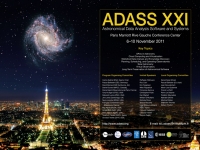Benchmarking the CRBLASTER Computational Framework on a
350-MHz 49-core MAESTRO Development Board
Kenneth Mighell (National Optical Astronomy Observatory)
Abstract
I describe the performance of the CRBLASTER
computational framework on a 350-MHz 49-core MAESTRO Development Board
(MBD). The 49-core Interim Test Chip (ITC) was developed by the U.S.
Government and is based on the intellectual property of the 64-core
TILE64 processor of the Tilera Corporation. The MAESTRO processor is
intended for use in the high radiation environments found in space;
the ITC was fabricated using IBM 90-nm CMOS 9SF technology and
Radiation-Hardening-by-Design (RHDB) rules. CRBLASTER is a
parallel-processing cosmic-ray rejection application based on a simple
computational framework that uses the high-performance computing
industry standard Message Passing Interface (MPI) library. CRBLASTER
was designed to be used by research scientists to easily port
image-analysis programs based on embarrassingly-parallel algorithms to
a parallel-processing environment such as a multi-node Beowulf cluster
or multi-core processors using MPI. I describe my experience of
porting CRBLASTER to the 64-core TILE64 processor, the MAESTRO
simulator, and finally the 49-core MAESTRO processor itself.
Performance comparisons using the ITC are presented between emulating
all floating-point operations in software and doing all floating point
operations with hardware assist from a IEEE 754 compliant Aurora FPU
(floating point unit) that is attached to each of the 49 cores.
Benchmarking of the CRBLASTER computational framework using the
memory-intensive L.A.COSMIC cosmic ray rejection algorithm and a
computational-intensive Poisson noise generator reveal subtleties of
the MAESTRO hardware design. Lastly, I describe the importance of
using real scientific applications during the testing phase of
next-generation computer hardware; complex real-world scientific
applications can stress hardware in novel ways that may not
necessarily be revealed while executing simple applications.Slides in PDF format
Paper ID: I07
|

